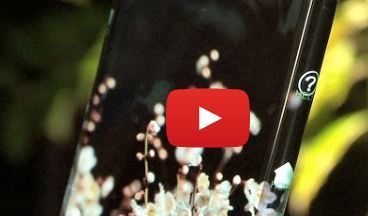SEL have developed a range of flexible OLED displays and high PPI LCD panels which use CAAC oxide semiconductors.
“CAAC stands for C-Axis Aligned Crystal. In this material’s structure, the crystals are aligned in the c-axis direction. Because CAAC itself is crystalline instead of amorphous, it has much higher reliability. Until now, with oxide semiconductors, reliability was generally thought to be a problem, but using this material solves that problem.”
“One point about CAAC is that it enables flexible displays that can be freely designed. Another point is, CAAC enables very high TFT drive performance, because its mobility is high. So, with this material, high resolution can be achieved even in big displays.”
As one way to utilize this flexibility, SEL have produced side-roll and top-roll OLED displays, with the display curving over the edge where a bezel would usually be.
The prototypes on show were a 3.4-inch 960×540 pixel display with a resolution of 326 ppi, and a 5.4-inch 960×1280 pixel display with a 302 ppi resolution. They still provide the high color reproduction characteristic of OLED displays.
“One feature of CAAC is, it doesn’t break easily, because the crystals are continuously aligned. So, it isn’t damaged much even if it’s bent. A display that can be bent into a diameter of 4 mm is probably unparalleled worldwide. In particular, this is the only technology that can display a picture on bent edges.”
SEL has also developed large flexible displays. This prototype is the world’s largest OLED display with a plastic substrate, at 13.5 inches. It’s a high-definition display, delivering 4K resolution at 326 ppi. The flexible material enables a lightweight, bendable display, less than 100 microns thick and weighing just 10 g.
“We’ve also made a bendable battery. As CAAC enables bendable displays, if those are combined with bendable batteries, one application is wearable devices.”
This prototype wrist device has a 3.4-inch OLED display and a bendable lithium ion battery. It supports Qi wireless charging and Bluetooth. In a test where the battery was repeatedly bent with the curvature expected in a wrist device, it could be put on and taken off over 10,000 times.
Technology for mass-producing CAAC-OS displays has already been established, and this type of display has been used in smartphones released by Sharp since the end of last year. Here, SEL presented a prototype high-definition, 513-ppi liquid crystal display, fabricated in pursuit of even higher precision.
“IGZO semiconductor with the CAAC structure, compared with the amorphous version used so far, performs at least an order of magnitude better. It can deliver about 20 times higher performance. That means the transistors can be made smaller, which enables displays to have higher definition. 513 ppi is probably world-class right now. That’s been achieved by producing high-performance transistors, using this CAAC technology.”
Source: Akihabaranews.com

